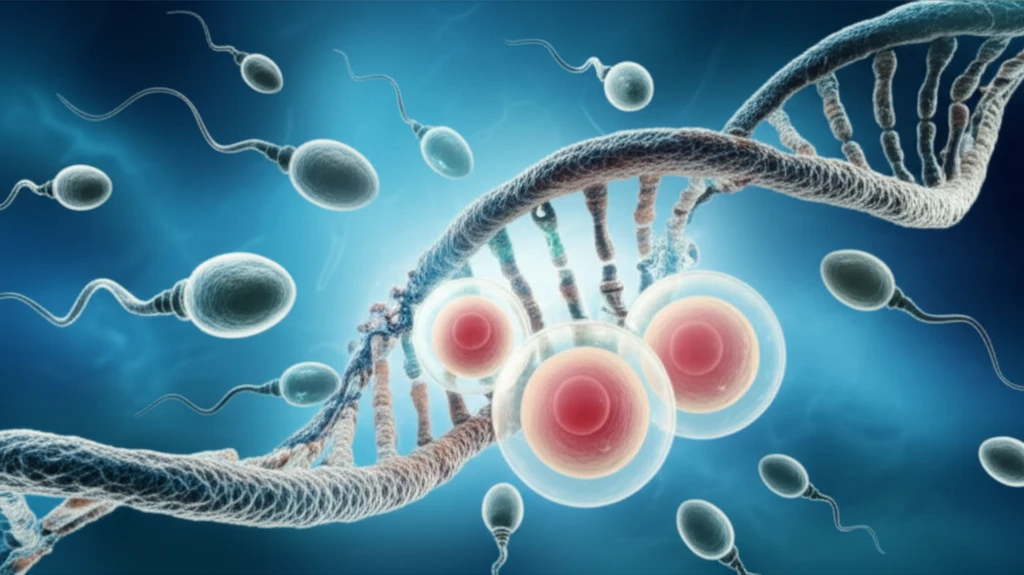
Decoding Our DNA: How 'Junk' DNA Shapes Human Evolution and Fertility
"New research reveals the surprising role of processed pseudogenes in both male and female reproductive cells, challenging old assumptions about the human genome."
For years, scientists thought pseudogenes were just genomic fossils—DNA sequences similar to genes but non-functional, evolutionary leftovers. Among these, processed pseudogenes, created when RNA is reverse-transcribed and inserted back into the genome, were particularly mysterious. Unlike their functional counterparts, they lack the usual controls and accumulate mutations, leading many to dismiss them as genomic 'junk'.
However, the human genome is full of surprises. Compared to other species, we have a surprisingly large number of these processed pseudogenes. One intriguing clue was the observation that our X chromosome has more of them than our other chromosomes, suggesting a link to the lengthy process of egg production in females. But could male reproductive cells also play a role?
This article explores new research that dives into the origins of processed pseudogenes, particularly those found on the human Y chromosome. By analyzing these genetic sequences, scientists are uncovering the hidden contributions of both male and female gametes to the evolution of our genome, challenging old assumptions and opening new avenues for understanding human fertility and genetic diversity.
Unlocking the Secrets of Processed Pseudogenes: Are They Really Junk?

The study tackled the question of processed pseudogene origins by focusing on the human Y chromosome. Researchers carefully analyzed the genetic sequences of processed pseudogenes found on the Y chromosome, comparing them to their 'parent' genes on other chromosomes. This painstaking work revealed a fascinating picture: some Y chromosome pseudogenes originated from genes located on the X chromosome, while others came from genes elsewhere in the genome. This suggests that processed pseudogenes aren't just passively accumulating; they're actively being created and inserted into our DNA.
- Shared Ancestry: Some processed pseudogenes on the Y chromosome share a common origin with sequences on the X chromosome, indicating an ancient link between these sex chromosomes.
- Retrotransposition Events: A significant number of processed pseudogenes appear to have arisen from retrotransposition events, where RNA molecules were reverse-transcribed and inserted back into the Y chromosome.
- Y-Linked Gene Activity: Genes located on the Y chromosome can also generate processed pseudogenes, demonstrating that the Y chromosome is not just a passive recipient of these genetic elements.
Rewriting the Textbook: Why Gametogenesis Matters
The discovery that both male and female germ cells actively contribute to the creation of processed pseudogenes has major implications. The researchers propose renaming the existing 'oogenesis hypothesis' to the 'gametogenesis hypothesis' to reflect the contributions of both male and female gametes. This broader perspective acknowledges that the creation of processed pseudogenes is not limited to egg production but occurs throughout the creation of both sperm and egg cells.
Furthermore, the study helps explain why the X chromosome has a higher density of processed pseudogenes than the Y chromosome. The team suggests the X chromosome is three times more abundant than the Y chromosome, leading it to accumulate more processed pseudogenes. For every four processed pseudogenes that are inserted into a sex chromosome, three will insert into an X chromosome and one into a Y chromosome.
In conclusion, this research suggests that processed pseudogenes are produced throughout the creation of both male and female gametes, and that the abundance of these pseudogenes on the X chromosome is due to its relatively high prevalence. These findings emphasize the low substrate specificity of L1 reverse transcriptase and the importance of gametogenesis for understanding the human genome.
